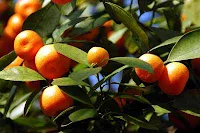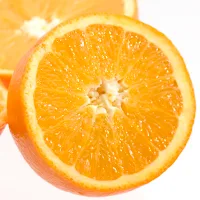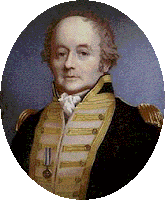Let's take a look at the orange in all its juicy goodness...
Origins of the orange... (like the wordplay there?)
It is still not universally agreed to be a distinct species, C. sinensis Osbeck, but it is usually treated as though it were. One of its first recorded regional names was the Persian narang, from which were derived the Spanish name, naranja, and the Portuguese, laranja. In some Caribbean and Latin American areas, the fruit is called naranja de China, China dulce, or simply China (pronounced cheena).
Most would be surprised that the orange we know today is not a natural, wild species, at least I know I was. It is assumed to have come from southern China, northeastern India, and perhaps southeastern Asia (formerly Indochina). In my research, I discovered that there is no one answer to, "Where do oranges come from?" Italians, ever the usurpers and perfectors of all things 'orient' are supposed to have brought it back to the Mediterranean after 1450, but history tells us it could also have been the
 Portuguese navigators around 1500. At that time period of history, all citrus fruits were valued by Europeans mainly for medicinal purposes, but the orange was quickly adopted as a luscious fruit and wealthy persons grew it in private conservatories, called orangeries. By 1646 it had been much publicized and was well known.
Portuguese navigators around 1500. At that time period of history, all citrus fruits were valued by Europeans mainly for medicinal purposes, but the orange was quickly adopted as a luscious fruit and wealthy persons grew it in private conservatories, called orangeries. By 1646 it had been much publicized and was well known. It's a common belief that the Spaniards most probably were responsible for the introduction of the sweet orange into South America and Mexico in the mid 1500s, and the French brought it to Louisiana. It was from New Orleans that seeds were obtained and distributed in Florida about 1872 and many orange groves were established by grafting the sweet orange onto sour orange root-stocks. Arizona received the orange tree with the founding of missions between 1707 and 1710. The
 orange was brought to San Diego, California, by those who built the first mission there in 1769. An orchard was planted at the San Gabriel Mission around 1804 and a commercial orchard was established in 1841 on a site that is now a part of Los Angeles. In 1781, a surgeon and naturalist on the ship Discovery, collected orange seeds in South Africa, grew seedlings on board and presented them to tribal chiefs in the Hawaiian Islands on arrival in 1792.
orange was brought to San Diego, California, by those who built the first mission there in 1769. An orchard was planted at the San Gabriel Mission around 1804 and a commercial orchard was established in 1841 on a site that is now a part of Los Angeles. In 1781, a surgeon and naturalist on the ship Discovery, collected orange seeds in South Africa, grew seedlings on board and presented them to tribal chiefs in the Hawaiian Islands on arrival in 1792.How popular are oranges? Well, the fact that the orange has become the most commonly grown fruit tree in the world might be some indication. It is an important crop in the Far East, the Union of South Africa, Australia, throughout the Mediterranean area, and subtropical areas of South America and the Caribbean. The United States leads in world production, with Florida, alone, having an annual yield of more than 200 million boxes. California, Texas and Arizona follow in that order, with much lower production in Louisiana, Mississippi, Alabama and Georgia.
Orange Varieties
Trovita
A non-navel seedling raised in 1914-1915 at the Citrus Experiment Station in California and released in 1935, is milder in flavor and has fewer seeds, but may be earlier in season, and it has been considered promising in hot, dry regions unsuitable for the Washington Navel. There are several other named variations such as Robertson Navel, Summer Navel, Texas Navel, and the externally attractive Thompson Navel which was grown in California for a time but dropped because of its poor quality.
Valencia or Valencia Late
This orange is the most important cultivar in California, Texas and South Africa. It has been the leader in Florida until recently. In 1984, 40% of the oranges being planted in Florida were Valencia, 60% were Hamlin. The Valencia may have originated in China and it was presumably taken to Europe by Portuguese or Spanish voyagers. The well-known English nurseryman, Thomas Rivers, supplied plants from the Azores to Florida in 1870 and to California in 1876.
Lue Gim Gong
This variety was claimed to be a hybrid of Valencia and Mediterranean Sweet made by a Chinese grower in 1886. Lue Gim Gong was awarded the Wilder Silver Medal by the American Pomological Society in 1911 but, later on, his hybrid was judged to be a nucellar seedling of Valencia. Propagated and distributed by Glen St. Mary Nurseries in 1912, this cultivar closely resembles Valencia, matures and is marketed with its parent without distinction. It is best cited as the Lue Gim Gong Strain of Valencia. Mediterranean Sweet was introduced into Florida from Europe in 1875, was briefly popular, but is no longer grown. Note**Certain strains of Valencia are classed as summer oranges because the fruits can be left on the trees longer without dehydrating. One is known as Pope, Pope Summer, or Glen Summer. It was found in a grove of Pineapple oranges near Lakeland about 1916, was propagated in 1935, and trademarked in 1938. On sour orange or sweet orange root stocks in hammock soils, the fruit matures in April but is still in good condition on the tree in July and August.
Rhode Red Valencia
This orange variety was discovered in 1955 in a grove near Sebring, Florida, by Paul Rhode, Sr., of Winter Haven. Some budwood was put on sour orange stock which caused dwarfing and some on rough lemon which produced large, vigorous, productive trees. In 1974, five trees were accepted into the Citrus Budwood Registration Program but there was no budwood free of exocortis and xyloporosis viruses. The fruit equals Valencia insoluble solids, excels Valencia in volume of juice, is less acid, has slightly less ascorbic acid, but has a far more colorful juice due to its high content of cryptoxanthin, a precursor of vitamin A which remains nearly stable during processing.
Hamlin
Discovered in 1879 near Glenwood, Florida, in a grove later owned by A.G. Hamlin, is small, smooth, not highly colored, seedless and juicy but the juice is pale. The fruit is of poor-to-medium quality but the tree is high-yielding and cold-tolerant. The fruit is harvested from October to December and this cultivar is now the leading early orange in Florida. On pine-land and hammock soil it is budded on sour orange which gives a high solids content. On sand, it does best on rough lemon rootstock.
Homosassa
A selected Florida seedling named in 1877, is of rich orange color, of medium size, and excellent flavor, It was formerly one of the most valued midseason oranges in Florida but was too seedy to maintain that position. It is no longer planted except perhaps in Texas and Louisiana.
Shamouti
(Jaffa, Khalili, Khalili White) originated as a limb sport on a Beledi tree near Jaffa, Israel, in 1844; introduced into Florida about 1883; oval, medium-large; peel entirely orange when ripe; leathery, thick, easy to remove; pulp very juicy, of good quality. It constitutes 75% of the Lebanese and Israeli crops and is one of the 2 main cultivars in Syria, but it is no longer planted in the United States.
Parson Brown
This variety was discovered in a grove owned by Parson Brown in Wester, Florida and was purchased, propagated and distributed by J.L. Carney between 1870 and 1878. It is rough-skinned, with pale juice; moderately seedy; of low-to-medium quality. It was formerly popular in Florida because of its earliness and long season (October through December), but has been largely replaced by Hamlin. It is grown in Texas, Arizona and Louisiana but is not profitable in California where it matures at the same time as Washington Navel. It does not develop acceptable quality in the tropics.
Pineapple
A seedling found in a grove near Citra, Florida, it was propagated in 1876 or 1877 under the name of Hickory. It is pineapple-scented, smooth, highly colored, especially after cold spells; of rich, appealing flavor, and medium-seedy. It is the favorite midseason orange in Florida, its tendency to preharvest drop having been overcome by nutrition and spray programs. It is grown to some extent in Texas, rarely in California; succeeds on sour orange rootstock in low hammock land, on rough lemon in light sand. Seedless mutants of Pineapple have been produced by seed irradiation. This cultivar does fairly well in tropical climates though not as well as Valencia.
Queen
This is a seedling of unknown origin which was found in a grove near Bartow, Florida. Because it survived the freeze of 1894-95, it was propagated in 1900 under the name King which was later changed to Queen. It is much like Pineapple, has fewer seeds, higher soluble solids, persists on the tree better in dry spells; is high-yielding and somewhat more cold-tolerant than Pineapple.
Blood Oranges
These are commonly cultivated in the Mediterranean area, especially in Italy (Sicilian Blood Oranges are prized the world over), and also in Pakistan. They are grown very little in Florida where the red coloration rarely develops except during periods of cold weather. In California they are grown only as novelties. Among the well-known cultivars in this group are Egyptian, which tends to develop a small navel; Maltese, Ruby, and St. Michael. The orange, its oils and properties have long been cultivated into numerous products that we use in our everyday households. The following is a brief list of some.
Orange juice is one of the commodities traded on the New York Board of Trade. Brazil is the largest producer of orange juice in the world, followed by the United States. It is made by squeezing the fruit on a special instrument called a "juicer" or a "squeezer."
Orange oil
Essential oil is a by-product of the juice industry produced by pressing the peel. It is used as a flavoring of food and drink and for its fragrance in perfume and aromatherapy. Orange oil consists of about 90 percent d-Limonene, a solvent used in various household chemicals, such as to condition wooden furniture, and along with other citrus oils in grease removal and as a hand-cleansing agent. It is an efficient cleaning agent, which is environmentally friendly, and much less toxic  than petroleum distillates. It also smells more pleasant than other cleaning agents.
than petroleum distillates. It also smells more pleasant than other cleaning agents.
Orange blossoms
The orange blossom is traditionally associated with good fortune, and was popular in bridal bouquets and head wreaths for weddings for some time. The petals of orange blossom can also be made into a delicately citrus-scented version of rosewater. Orange blossom water is a common part of Middle Eastern cuisine. The orange blossom gives its touristic nickname to the Costa del Azahar ("Orange-blossom coast"), the Valencia seaboard.
Tea
In Spain, fallen blossoms are dried and then used to make tea.
Orange blossom honey
Orange blossom honey, or actually citrus honey, is produced by putting beehives in the citrus groves during bloom; where the bee ollinates seeded citrus varieties. Orange blossom honey is highly prized, and tastes much like an orange.
Marmalade
Marmalade is a conserve usually made with bitter or sour oranges, which are too sour and astringent to eat raw. All parts of the orange are used to make marmalade: the pith and pips are separated, and typically placed in a muslin bag where they are boiled in the juice (and sliced peel) to extract their pectin, aiding the setting process.
Orange peel
Orange peel is used by gardeners as a slug repellent. The unripe fruit called narthangai is commonly used in Southern Indian food, especially in Tamil cuisine. The unripe fruit is pickled by cutting it into spirals and stuffing it with salt. The pickle is usually consumed with thayir sadam (curd rice).
The whole package....
Such is the versatility of the orange, that virtually every part of this friut from seedlings, to flowers and blossoms to the bark of the tree is utilized in some way or another.
Peel
 In addition to its food uses, orange peel oil is a prized scent in perfume and soaps. Because of its 90-95% limonene content, it has a lethal effect on houseflies, fleas and fireants. Its potential as an insecticide is under investigation. It is being used in engine cleaners and in waterless hand-cleaners in heavy machinery repair shops. It is commercially produced mainly in California and Florida, followed distantly by Italy, Israel, Jamaica, South Africa, Brazil and Greece, in that order. Terpenes extracted from the outer layer of the peel are important in resins and in formulating paints for ships. Australians have reported that a shipment of platypuses sent to the United States in the 1950s was fed mass-produced worms raised on orange peel.
In addition to its food uses, orange peel oil is a prized scent in perfume and soaps. Because of its 90-95% limonene content, it has a lethal effect on houseflies, fleas and fireants. Its potential as an insecticide is under investigation. It is being used in engine cleaners and in waterless hand-cleaners in heavy machinery repair shops. It is commercially produced mainly in California and Florida, followed distantly by Italy, Israel, Jamaica, South Africa, Brazil and Greece, in that order. Terpenes extracted from the outer layer of the peel are important in resins and in formulating paints for ships. Australians have reported that a shipment of platypuses sent to the United States in the 1950s was fed mass-produced worms raised on orange peel.
Seeds
Oil derived from orange and other citrus seeds is employed as a cooking oil and in soap and plastics. The high-protein seed residue is suitable for human food and an ingredient in cattlefeed, and the hulls enter into fertilizer mixtures.
Flowers and foliage
 The essential oils distilled from orange flowers and foliage are important in perfume manufacturing. Some Petitgrain oil is distilled from the leaves, flowers, twigs, and small, whole, unripe fruits.
The essential oils distilled from orange flowers and foliage are important in perfume manufacturing. Some Petitgrain oil is distilled from the leaves, flowers, twigs, and small, whole, unripe fruits.
Nectar
The nectar flow is more abundant than that from any other source in the United States and is actually a nuisance to grove workers in California, more moderate in Florida. It is eagerly sought by honeybees and the delicious, light-colored honey is widely favored, though it darkens and granulates within a few months. Citrus honey constitutes 25% of all honey produced in California each year. There are efforts to time pest-control spraying to avoid adverse effects on honeybees during the period of nectar-gathering. The wood is yellowish, close-grained and hard but prone to attack by drywood termites. It has been valued for furniture, cabinetwork, turnery and engraver's blocks. Branches are fashioned into walking-sticks. Orange wood is the source of orange sticks used by manicurists to push back the cuticle.
Medicinal Uses
Oranges are eaten to allay fever and catarrh. The roasted pulp is prepared as a poultice for skin diseases. The fresh peel is rubbed on acne. In the mid-1950s, the health benefits of eating peeled, whole oranges was much publicized because of its protopectin, bioflavonoids and inositol (related to vitamin B). The orange contains a significant amount of the vitamin-like glucoside, hesperidin, 75-80% of it in the albedo, rag and pulp. This principle, also rutin, and other bioflavonoids were for a while much advocated for treating capillary fragility, hemorrhages and other physiological problems, but they are no longer approved for such use in the United States. Orange flower water, made in Italy and France as a cologne, is bitter and considered antispasmodic and sedative. A decoction of the dried leaves and flowers is given in Italy as an antispasmodic, cardiac sedative, antiemetic, digestive and remedy for flatulence. The inner bark, macerated and infused in wine, is taken as a tonic and carminative. A vinous decoction of husked orange seeds is prescribed for urinary ailments in China and the juice of fresh orange leaves or a decoction of the dried leaves may be taken as a carminative or emmenagogue or applied on sores and ulcers. An orange seed extract is given as a treatment for malaria in Ecuador but it is known to cause respiratory depression and a strong contraction of the spleen.
Well there you have it. Most of us simply go to the market, pick the items we want, take them home and enjoy our little delights without ever giving a second thought as to the origin of what it is we put in our bodies. We like the taste, the look, or the feeling it gives us. (That last part is really about my addiction to chocolate, but we'll leave that discussion for another feature and another day). I hope you learned a bit. I know I did.
Bon Appetit!
Lou
Sources: www.hort.purdue.edu, www.orange.com, www.ikipedia.org, www.budgetermite.com, www.static.howstuffworks.com www.affordablehomeandgardenstore.com, www.naturehills.com, www.ridgeislandgroves.com, www.justfoodnow.com, www.aggie-horticulture.tamu.edu,, www.cookinglight.com, www.mydish.co.uk., www.dpi.nsw.gov.au, www.aromatherapywellness.com











































